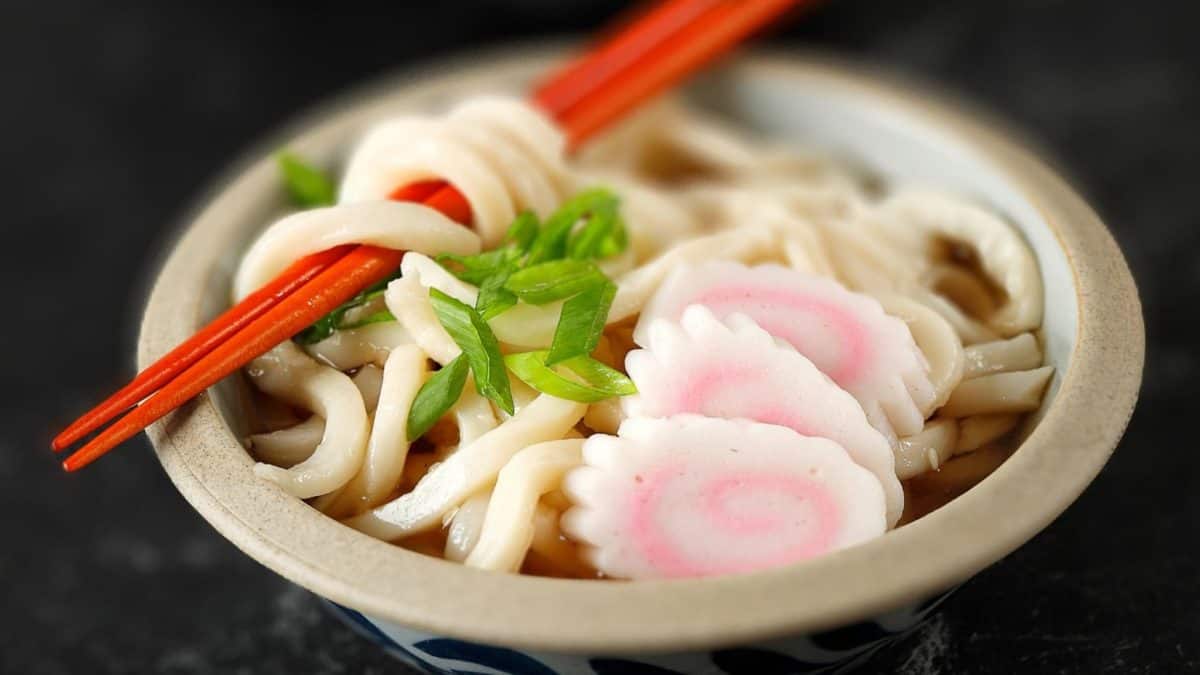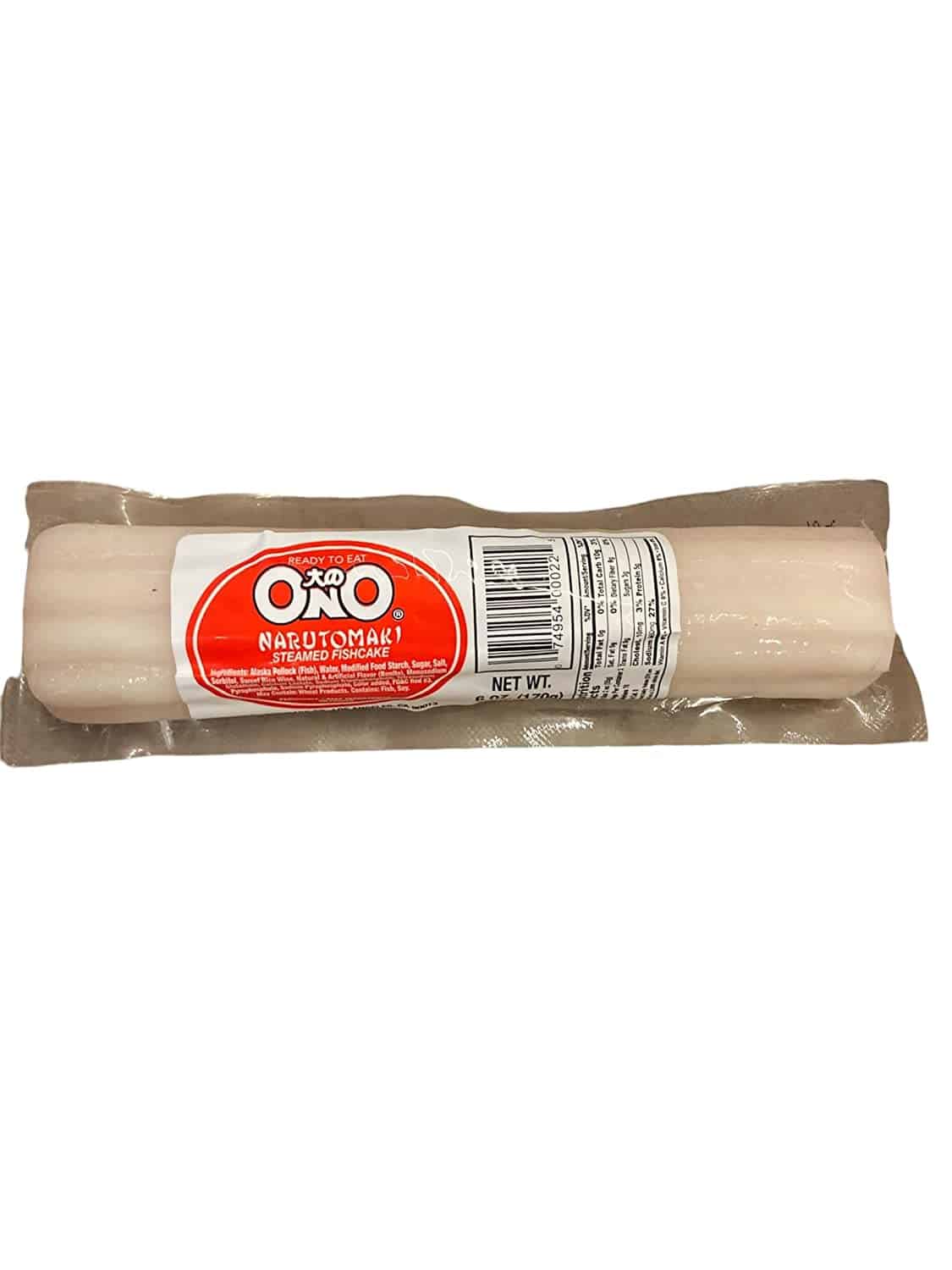Narutomaki: The Swirly Naruto Fish Cake Rolls In Your Ramen
Narutomaki is a type of Japanese fish cake. It is made by wrapping a seasoned fish paste around another layer made pink with food coloring and then steaming it. The resulting cake is white with pink spirals running through it.
Narutomaki is often used as a decoration or garnish in Japanese cuisine and can be found in soups, noodle dishes, and rice balls.
It is also a popular snack food, and can be purchased pre-packaged from most convenience stores in Japan.


Check out our new cookbook
Bitemybun's family recipes with complete meal planner and recipe guide.
Try it out for free with Kindle Unlimited:
Read for freeIn this post we'll cover:
- 1 What does “narutomaki” mean?
- 2 What does narutomaki taste like?
- 3 Best narutomaki to buy
- 4 How do you eat narutomaki?
- 5 What’s the difference between narutomaki and kamaboko?
- 6 What’s the difference between narutomaki and imitation crab?
- 7 Narutomaki ingredients
- 8 Variations of Japanese narutomaki
- 9 History of narutomaki
- 10 FAQ on narutomaki Japanese fish cake
- 11 Is narutomaki healthy?
- 12 Conclusion
What does “narutomaki” mean?
The word “narutomaki” is a combination of the Japanese words for “rolled up” (maki, just like the sushi) and naruto, likely to have come from the whirlpools in the Naruto Strait between Awaji and Shikoku Island.
Is narutomaki named after Naruto?
Narutomaki is not named after naruto, but they both stem from the same idea or “design” of a whirlpool-like swirl in the center. It is likely naruto was named after narutomaki, though, or they both were named after the whirlpools in the Naruto Strait.
What does narutomaki taste like?
Narutomaki has a mild fish flavor with a pretty chewy texture. The taste is not overpowering even though it’s made from white fish and the texture goes perfectly with broths, like eating it in a bowl of ramen.
Best narutomaki to buy
If you want an authentic taste, this Ono narutomaki log is a great choice:

How do you eat narutomaki?
There is no wrong way to eat narutomaki, but it is typically sliced thinly and added as a garnish to soups, noodle dishes, and rice balls. It can also be enjoyed on its own as a snack food.
What’s the difference between narutomaki and kamaboko?
Narutomaki is one of many types of kamaboko. “Kamaboko” is the Japanese word for fish cakes, and narutomaki is the specific one with a pink swirl and zig-zag edge.
What’s the difference between narutomaki and imitation crab?
Imitation crab is made from white fish, pulverized and shaped, and seasoned to resemble crab meat. It is often flavored with crab or shellfish extract and contains no actual crab meat. Narutomaki is made from seasoned fish paste and created into a log with a pink swirl in the middle.
Narutomaki ingredients
Narutomaki is made from white fish, pink food coloring, mirin, sake, and fish sauce.
Variations of Japanese narutomaki
Did you know that there are two types of naruto kamaboko?
The most common variety you see is the classic white exterior with a pink swirl interior. The Japanese consider this to be the “regular” and “traditional” narutomaki.
On the other hand, narutomaki refers to the inverted color version of this dish. The exterior or base layer is all pink colored, and the inside swirl is white. This variety is less common and almost exclusive to 3 Japanese regions: Hokkaido, Tohoku, and Kyushu.
Some experimental chefs like to play around with the colors. You may see a white exterior with a green swirl inside.
Some even replace the swirl with symbols and other patterns! For example, the Sho Chiku Bai is a plum, pine, and bamboo pattern representing the Japanese icon of happiness.
History of narutomaki
You might be wondering: why is naruto such a common ramen topping?
It has a long tradition in Japanese cuisine, but its primary role is not to enhance flavor, but to add visual contrast to the soup’s brownish colors.
The naruto cake has a ridged exterior edge and a pretty pink center, so it enhances any dish’s presentation!
Initially, Japanese chefs used naruto as a topping for soba noodles in the Edo period (about 150 years ago).
At the time, ramen wasn’t even invented yet. Ramen was popularized sometime in the early 1900s when it was brought over from China.
Since narutomaki was a popular topping for soba, people quickly adapted it for ramen since it was also a noodle dish.
Learn all about these 8 different types of Japanese noodles (with recipes)
FAQ on narutomaki Japanese fish cake
Below, I’ll answer some more questions you might have about Japanese fish cake!
Is narutomaki Japanese fish cake healthy?
As with any fish dish, the health and nutritional benefits depend on the fish’s quality and the preparation methods.
In general, well-made kamaboko is full of health benefits. It’s low in fat, full of good nutrients, and has lots of protein.
Also, this dish is low in calories, so it’s not a source of dangerous fats. It also has antioxidant properties, helping the body neutralize free radicals.
However, there’s one disadvantage.
Most of the cheaper store-bought kamaboko and narutomaki are high in sodium and contain MSG.
If you want healthier options, look for higher-priced products that are produced using high-quality white fish. Also, check the list of ingredients and avoid anything with too many additives and preservatives.
Where can I buy narutomaki?
So, you’re wondering where to find kamaboko and narutomaki?
The best place to go is Asian grocery stores. Or you can eat it at ramen restaurants.
Can you make narutomaki at home?
It’s uncommon for Japanese people to make narutomaki at home because it’s an elaborate dish. Making it requires many steps and specialized tools.
The ingredients are often hard to get, and it’s a time-consuming cooking process too.
So most people buy this dish at the supermarket or eat it while dining at a ramen restaurant.
Is narutomaki healthy?
Yes, narutomaki is healthy! It is a good source of protein and low in calories. Plus, it contains no saturated fat or cholesterol.
It is high in sodium though so you should avoid eating too much of it.
Conclusion
Narutomaki are those excellent swirly kamaboko you can put in your ramen and they are great fish cakes to have in your freezer as well. That way, you’ll always have some when you need it.
Check out our new cookbook
Bitemybun's family recipes with complete meal planner and recipe guide.
Try it out for free with Kindle Unlimited:
Read for freeJoost Nusselder, the founder of Bite My Bun is a content marketer, dad and loves trying out new food with Japanese food at the heart of his passion, and together with his team he's been creating in-depth blog articles since 2016 to help loyal readers with recipes and cooking tips.

